The Roeblings
Today, a family gives us the Brooklyn Bridge. The University of Houston's College of Engineering presents this series about the machines that make our civilization run, and the people whose ingenuity created them.
Perhaps you've seen the Brooklyn Bridge with its graceful proportions and beautiful tracery of suspension cables. It's a wonderful thing and the crowning glory of the Roebling family.
The father, John Roebling, was born in Prussia in 1806, and he graduated from the Berlin Polytechnic school. Then it happened that the philosopher Hegel told him America was "a land of hope for all who are wearied of the historic armory of old Europe." Roebling liked the sound of that. He moved here in 1831.
First he worked on canal equipment. Soon he'd invented wire cable to replace the hemp towropes. By now, the first small suspension bridges were just appearing, and it struck Roebling that, held up by wrought iron cable instead of rope, suspension bridges could be made very large. He won a contract to bridge the Monongahela River with an 8-span, 1500-foot bridge. He finished it in 1846.
But the bridge that first made Roebling's name was the one over Niagara Falls. He followed it with the Cincinnati Bridge -- a single span, over a thousand feet long. He finished it in 1866, and it's still in use today.
By then Roebling was just convincing backers he could build a great 1600-foot, single-span suspension bridge from Manhattan to Brooklyn. The Brooklyn Bridge was hotly opposed by ferryboat operators who stood to lose money and by citizens who didn't believe it could be done. Roebling was not shy. He said,
[It] will not only be the greatest bridge in existence,
but it will be the greatest engineering work of the ... age.
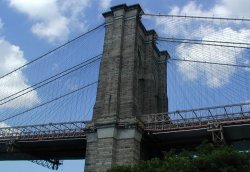 Then, while he was surveying the site, his foot got crushed under a loose piling. He died of tetanus, and his son, Washington Roebling, took up the work. It was a terrible task -- plagued by accidents, deaths, and the paralyzing caisson disease, also called the bends. Nitrogen bubbles came out of the workers' blood when they were depressurized after laboring in caissons under the East River. The bends almost killed Washington Roebling.
Then, while he was surveying the site, his foot got crushed under a loose piling. He died of tetanus, and his son, Washington Roebling, took up the work. It was a terrible task -- plagued by accidents, deaths, and the paralyzing caisson disease, also called the bends. Nitrogen bubbles came out of the workers' blood when they were depressurized after laboring in caissons under the East River. The bends almost killed Washington Roebling.
No longer able to walk, or even to talk, he supervised the work from the window of a house in Brooklyn Heights. It was actually his wife, Emily Roebling, who did the on-site supervision. Finally, in 1883, Washington Roebling watched from his window while President Chester Arthur, President-to-be Grover Cleveland, and the citizens of New York opened the longest suspension bridge in the world.
So the creative impulse of three Roeblings made the Brooklyn Bridge, and it cost them dearly. The graceful, familiar, fan-like cross-bracing is a pure John Roebling touch. That sweeping use of cable makes the bridge into a powerful icon. And it is what moved Hart Crane to write to the bridge,
O Sleepless as the river under thee, ... sweep, descend
And of the curveship lend a myth to God.
I'm John Lienhard, at the University of Houston, where we're interested in the way inventive minds work.
(Theme music)
Vogel, R.M., Building Brooklyn Bridge: The Design and Construction, 1873-1883. Washington, D.C.: The National Museum of American History, Smithsonian Institution, 1983.
Vogel, R. M., Roebling's Delaware & Hudson Canal Aqueducts. Washington, DC: Smithsonian Institution Press, 1971.
Vogel, R. M., Designing Brooklyn Bridge. Annals of the New York Academy of Sciences, Vol. 421, 1983, 3-39.
This is a revised version of Episode 87.
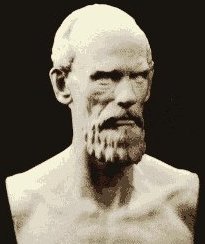
Bust of John Roebling. The bust belongs to Rensselaer Polytechnic Institute)
From the Vogel reference above
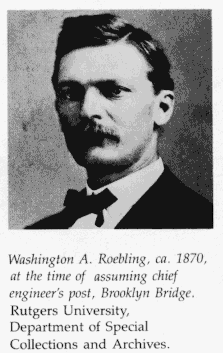
Washington Roebling
From the Vogel reference above
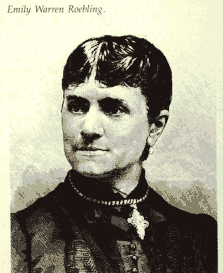
Emily Roebling
From the Vogel reference above
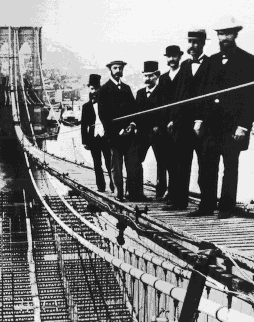
The Brooklyn Bridge under construction in 1881
From the Vogel reference above